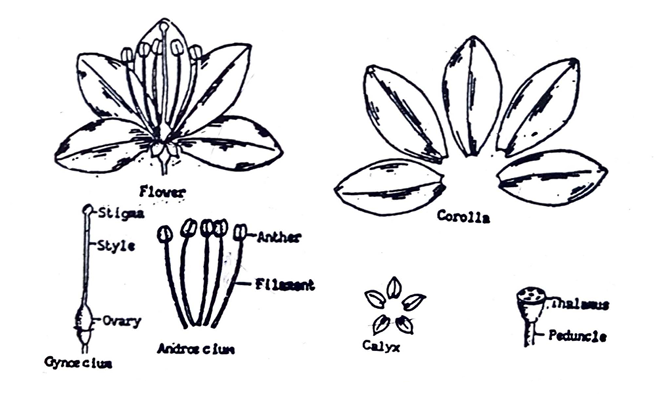In pharmacognosy, the term flower drugs is used in a collective sense for commercial purposes and the sample includes· not only the flowers but also a number of inflorescences. In some cases, the sample may not contain a whole flower or inflorescence but only a part of the flower. However, for the sake of identification and detection of adulterants, pharmacy students should be familiar with the botanical description of a flower.
Macroscopical characters of flowers
The flower is a modified shoot of limited growth, bearing reproductive organs in a compactly arranged structure. A typical flower consists of four floral Parts; two lower accessory parts,· the calyx and the Corolla and two upper essential parts of reproductive organs, the androecium (male) and the gynoecium or pistil (female). All these four parts are composed of a number of individual units. The units of the calyx are called the sepals, those of the Corolla, the petals, those of the androecium, stamens and those of the gynoecium, the carpels. Each stamen is diffe~entiated into a filament (the stalk) and an anther (the pollen-bearing sac), and the pistil is differentiated into an ovary (the Iower swollen part containing the ovules), a style (the elongated tube) and a stigma (the elongated tube) and a stigma (the expanded or modified tip of the style). All the four parts develop in ascending order on the swollen end (the thalamus or receptacle or torus) of the floral axis or stalk, the pedicel. Figure 35 shows the various parts of a flower.
Flowers develop on the stem either single (called solitary flowers) or collectively. i.e., in clusters. The branch or branch system that bears a collection of flowers is called in inflorescence. The inflorescence may be terminal or axillary in position and may be branched in various ways. The main axis of the inflorescence, called the peduncle, may be of indefinite growth producing flowers laterally, in which case, the inflorescence is called racemose, or it may cease to grow indefinitely ending in a terminal flower and producing lateral branches below the terminal flower. These lateral branches also terminate in a flower and produce lateral branches like the main axis and the process is repeated. This type of inflorescence is called cymose inflorescence. Each of these two main types of inflorescences has a number of different types depending on the type of branching and arrangement of flowers (Students should refer to any standard textbook of botany for details)

Fig. 32: Parts of a typical flower, (Reconstructed from Bhuya & Timm).
External characters of the Flowers
The external characters of the flowers are those of the floral parts, the thalamus and the pedicel. The epidermises of the sepals closely resemble those of the leaves and stems of the same plant. The external characters of the sepals also include the stomata and trichomes as those of the leaves. The upper epidermis of the petals is frequently papillose, a condition that gives them a velvety appearance. The papillae of the petals constitute a very useful diagnostic character of flowers. The epidermal cells of the petals usually contain coloured pigments, which give them the characteristic colours. Typical glands and trichomes are also present on the petals. The external characters of the stamens and pistils are not as apparent as those of the other parts except for occasional presence of trichomes· on the staminal column or filament and the characteristic surface appearance of the anther and ovary walls. The pedicel often bears both covering and glandular trichomes, which sometimes offer important characters for the identification of flower drugs.
Microscopical characters of flowers
The microscopical and anatomical (histological) characters of flowers are of great significance in the study of flower drugs. The sepals possess two (upper and lower or outer and inner) epidermises like the leaves and the epidermal cells also resemble those of the leaves or stems. Stomata and trichomes (both clothing and glandular) are frequently present. The mesophyll of the sepals resembles. the spongy tissue of the leaves and most of them contain chloroplasts. The petals also have two epidermises. The upper or inner epidermis is frequently papillose while the lower or outer one is without papillae but often contains stomata. Their mesophyll is thin and consists of 3 to 4 rows of cells with large intercellular spaces. Typical glands and trichomes are common on the petals. The narrow veins consist of very narrow spiral vessels. The anther walls show the characteristic fibrous layer or endothelium, which consists of parenchymatous cells, each containing a spiral band of lignified thickening. The size, shape, sculpturing and markings of the pollen grains are characteristic of different flowers. The form, size and arrangement of the papillae of the stigma also vary from flower to flower and often serve as useful histological characters for the identification of some flowers.
Flower drugs may consist of flower buds, e.g. Cloves, or inflorescences such as Convallaria, Chamomile, Arnica, or individual flowers, e.g., Pyrethrum, Santonica, or floral parts, e.g., Saffron (stigmas), Red poppy (corolla), Elderflowers (Corolla and stamens).
There are a large pharmaceutically and number of flowers, which constitute commercially useful drugs. Some of them are described below in the form of Monographs as representative examples for the students so that they can also describe other flower drugs.

Nice one❤❤❤🙏🙏👍👍